1950's - The Rocking Fifties
Holiday Camps
|
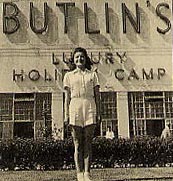
Camper pictured here
at Clacton in 1955.
|
The phenomenal appeal of the television comedy series Hi-De-Hi was based on nostalgia for the holiday camp, so much a part of post-war summertimes.
The yellow-jackets, tweenies and dancing masters of the series were achingly familiar characters from real life -- hybrids of the red-coats and other camp personnel who had bustled real holiday-makers about, arranging toy-golf, ping-pong and party games, 'knobbly knees' and 'lovely ladies' competitions, and generally making sure that no one was left out.
It was organised merriment -- and it was highly successful. The pioneer in the field was Billy Butlin, who opened his first simple camp in Skegness in 1936.
But his formula of an all-in-payment for accommodation, three daily meals and non-stop entertainment did not really reap rewards until the 50's, when families on low incomes were eager to escape the drabness of grey cities, still pock-marked by bomb sites and made joyless by post-war austerity.
So successful was Butlins that rivals, such as Pontins and Warners were soon erecting camps on seaside sites and duplicating the winning formula: brightly painted chalets and buildings and thousands of flowers.
Silence was abhorred: jolly announcements on the public address system punctuated non-stop piped music. Children were kept amused with games in nurseries and play groups, and at night well-known performers filled the specially-built theatres.
Organised fun was the order of the day at a Butlin's holiday camp, and a smile was de rigeur - even when dressed for gym, like the
Now we tend to laugh at the camps rather than in them, but in their heyday they provided fun for millions.
|
|
The Rank Charm School
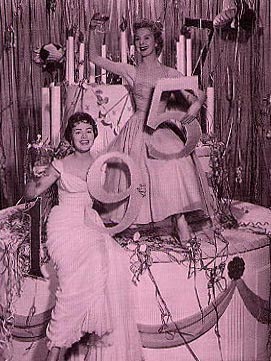 J Arthur Rank's 'man with the gong' was the symbol of British cinema in the 50's. J Arthur Rank's 'man with the gong' was the symbol of British cinema in the 50's.
He represented an organisation that was based on the American studio system, and like them kept a roster of stars on contract, the younger of whom were groomed for stardom in the 'Company of Youth' - otherwise known as 'The Charm School'.
While Charm School pupils were trained in the techniques of cinema acting and handling the public, they also were expected to behave themselves on and off set.
Rank could suspend a contract if the gossip columns got wind of any scandal that might reflect badly on the Company.
Diana Dors, one of the school's first signings, became Britain's first and most famous sex-symbol. But a later graduate achieved international stardom 25 years after the School had closed: that queen of soap and determinedly ageless siren, Joan Collins.
The Rank Charm School was a boon to the national press, which was always eager to print publicity pictures of the stars: in this case Beth Rogan and June Laverick, seen here celebrating Christmas 1957.
|
|
'Sunday Night at the London Palladium'
The flagship programme of newly-launched ITV, SUNDAY NIGHT AT THE LONDON PALLADIUM first appeared on September 25, 1955.
At first only the 190,000 viewers who had bothered to have their sets converted watched, but soon it became essential Sunday viewing, seen by more than 20 million at the height of its popularity.
For 12 seasons a compere hosted a mix of showgirls, magicians, singers, comedians -- and, of course, the audience-participation game, 'Beat the Clock'.
The invitation to top the bill at the Palladium attracted some of the biggest stars in show-business, including Judy Garland, The Beatles and the Rolling Stones.
Only the latter refused to mount the famous revolving stage for the traditional finale, in case it impaired their carefully cultivated air of rebellion.
The London Palladium: The Story of the Theatre and Its Stars
|
|
Teddy Boys and Rock-and-Roll
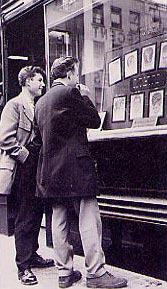 The children of the war years came of age in the 50's, and some of them could hardly wait to declare a war of their own -- on adult values and propriety. The children of the war years came of age in the 50's, and some of them could hardly wait to declare a war of their own -- on adult values and propriety.
In the vanguard of rebellion was a colourful -- and often violent -- minority of youths called 'Teddy Boys', originally called Edwardians.
They made their appearance in the early 50's, and prided themselves on a supposed look of Edwardian gents, long 'drape' jackets with velvet collars and cuffs, 'drainpipe' trousers, and thick crepe-soled shoes.
In their peaceful moods, they were 'hep' and 'in the groove' -- a new attitude that reflected both the music and lyrics of rock-and-roll.
But some of the time there was nothing genteel about their behaviour: they picked fights in dance-halls and rioted in cinemas - where the 'youth oriented' film THE BLACKBOARD JUNGLE was showing -- and smashed windows. These riots were sparked by the record ROCK AROUND THE CLOCK.
These two films introduced Bill Haley and the Comets, who became enormously popular with British teenagers. The police and parents were not quite so keen, however.
On September 11,1956, the newspapers were filled by shocking reports of riots at cinemas showing ROCK AROUND THE CLOCK: teddy boys were jiving in the aisles, chanting "We want Bill," and "Rock, rock, rock," and ripping seats.
Hundreds were arrested, charged and fined for 'insulting behaviour.'
In Bill Haley's wake came the even wilder rhythms of black artists like Chuck Berry ad Little Richard, though these were more restricted in their appeal.
But it took Elvis Presley, a sullenly handsome young truck-driver from Memphis, Tennessee, to change the face of popular music, with his1956 hit HEARTBREAK HOTEL and the follow-ups HOUND DOG, JAILHOUSE ROCK and ALL SHOOK UP.
Fifty-four million people saw Elvis 'the Pelvis' grunt and writhe on America's ED SULLIVAN SHOW on September 9, 1956. But official disapproval only added to Presley's appeal; teenagers would never be the same.
|
|
The Brylcreem Boy
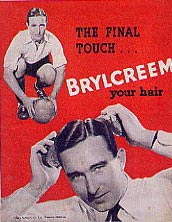 With so many young men playing a life or death game on the battlefields of Europe, the war years had hardly been a golden age for British sport. So when normality returned, the country needed a sporting hero, and he came in the person of Dennis Compton. With so many young men playing a life or death game on the battlefields of Europe, the war years had hardly been a golden age for British sport. So when normality returned, the country needed a sporting hero, and he came in the person of Dennis Compton.
In any era, the Middlesex cricketer would have merited a place in the record books: the 3,816 first-class runs he scored in 1947 were the highest number ever recorded in a season.
But Compton was a figure of glamour, style and nonchalant flair: a golden boy, who also played football for Arsenal, and even appeared for England.
The advertising agents soon saw his potential, and his features were immortalised in a series of hair cream advertisements: commercialism had finally come to sport.
|
The Angry Young Men
|
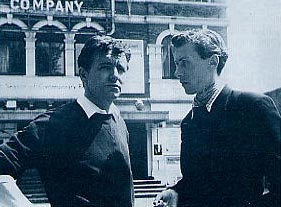
John is pictured on the right, with Kenneth Haigh on the left, playing Jimmy Porter. LOOK BACK IN ANGER was bitter tirade against the values of the Establishment.
|
Disenchantment with the established order took many forms among the young in the 50's. For the intellectual products of the new redbrick universities and grammar schools, revolt took a more literary bent.
The 'Angry Young Men' were a desparate group of writers whose unifying theme was the misfit in society, up against a system steeped in class.
The unofficial but undisputed leader of the pack was John Osborne, whose play LOOK BACK IN ANGER, first produced at London's Royal Court Theatre in May 1956, caused a sensation.
His tormented working-class anti-hero, Jimmy Porter, shocked yet fascinated the largely middle-class audiences. So did Joe Lampton, the amoral and ambitious protagonist of John Braine's 1957 novel, ROOM AT THE TOP.
Other angry young men were John Wain (HURRY ON DOWN, 1953), Alan Sillitoe (SATURDAY NIGHT AND SUNDAY MORNING, 1958) and the more humorous Kingsley Amis (LUCKY JIM, 1956).
|
The Ealing Comedies
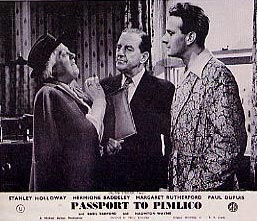 Good humour, whimsy, a certain gentle satire and an essential Britishness were the hallmarks of the Ealing comedies, produced by Michael Balcon in the late 40's and 50's, the films included THE LAVENDER HILL MOB, PASSPORT TO PIMLICO and WHISKEY GALORE. Good humour, whimsy, a certain gentle satire and an essential Britishness were the hallmarks of the Ealing comedies, produced by Michael Balcon in the late 40's and 50's, the films included THE LAVENDER HILL MOB, PASSPORT TO PIMLICO and WHISKEY GALORE.
For many Ealing Comedy means Sir Alec Guiness -- the Admiral standing to attention as he sinks beneath the waves; Lady Agatha defying the skies in her balloon: both these vignettes from KIND HEARTS AND CORONETS encapsulate a golden age of cinema.
|
Furniture of the 50's
The 1951 Festival of Britain was a celebration of 'contemporary style': its buildings were dominated by steel and aluminium, and the furniture shown was made from the new materials in vogue: fibre-glass, plywood, Formica and plastics.
Chairs by designer Ernest Race, made of steel rods curved into sinuous shapes, were at the forefront of the style, with its echoes of science fiction.
|
Tony Curtises, Crewcuts and DAs
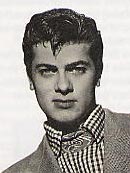 During the 50s, new hairstyles swept across the Atlantic, and soon every barber's shop advertised a range of different looks. During the 50s, new hairstyles swept across the Atlantic, and soon every barber's shop advertised a range of different looks.
The sultry good looks of Tony Curtis swept him to stardom in THE SWEET SMELL OF SUCCESS, in 1957, and before long teenagers on both sides of the Atlantic were copying his hairstyle -- not always with the approval of their parents.
Nevertheless, the advent of Tony Curtises, crewcuts and DA's marked a change in notions of masculinity: no longer did manliness mean a severely cut short-back-and-sides.
Film star Tony Curtis gave his name to a well-oiled swathe of hair over the forehead. The crew cut, an unflattering, half-shaven style, was popular in America and France. But Elvis Presley's DA was a necessity for every teddy boy.
Neither the style nor the name -- inspired by the back view of a duck -- were as well liked by parents.
|
The Dockers
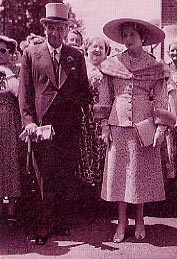
Lady Docker, photographed at the first day of Royal Ascot 1955, was always at the forefront of fashion, seen here in a wide-brimmed hat, an opulent mink stole and a lace dress.
|
The desire for release from austerity and dim duty was nowhere more evident than in the public's fascination with the publicity seeking Sir Bernard and Lady Docker.
From the late 40's -- when Sir Bernard, Chairman of the Daimler Company, married Norah Collins, a one-time dancer at the Café de Paris -- and throughout the 50's, the gracelessly gaudy pair entertained the nation with a succession of fancy cars, mink coats, champagne receptions and the magnificent SHEMARA, an 860-ton yacht with a crew of 35.
It was conspicuous consumption on a massive scale. While people on the Clapham omnibus shook their heads in disbelief, they were somehow grateful for the chance to wonder at a glamour and unabashed extravagance they had long been denied.
Lady Docker was the real showstopper; Sir Bernard was the complaisant supplier of her far from petty cash.
Her cars were probably Lady Docker's best-known asset: in 1951, Prattley, her chauffeur, drove an initialled gold Daimler with gold-plated fittings.
Later, she had a metallic-blue version with lizard-skin upholstery; by 1953, her car was a Daimler Silver Flash with red crocodile-leather seats.
It was another era: miners did not feel patronised when she invited them aboard her yacht -- 40 turned up to be served pink champagne.
When £15,000-worth of her jewels were stolen, Billy Hill, the former 'King of the Underworld' vowed to get them back - "I admire Lady Docker," he said. "She's not afraid to mix with people like me."
But the Dockers could not get away with it forever. After defending his extravagant life-style at a press conference at the Savoy Hotel, Sir Bernard lost his chairmanship of Daimler at the end of 1956.
By 1958 they were reduced to selling Lady Docker's jewellery and, finally, in 1968, the famous yacht SEMARA.
By then they were tax-exiles in a smallish bungalow on Jersey, but Lady Docker had not lost her punch. Obviously, the island and its people held few charms for her.
"They're the most frightfully boring, dreadful people that have ever been born," she observed. Unfortunately, there is no record of what the people of Jersey thought of her.
|
|
|


